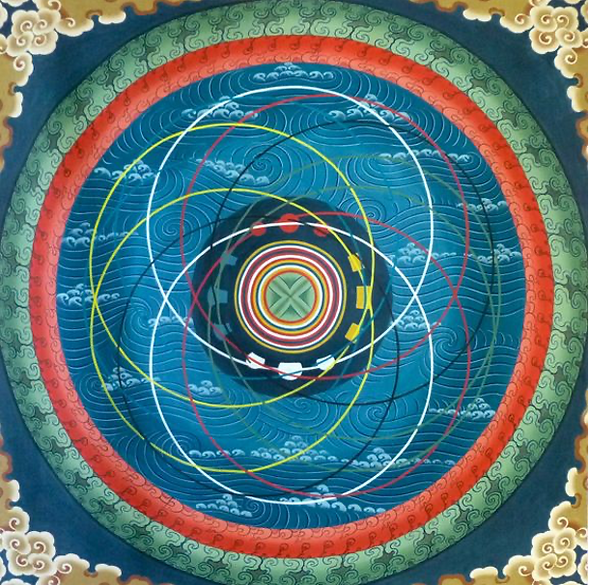Dzogchen
The Great Perfection

Dzogchen, often translated as the “Great Perfection,” is regarded as the highest and most direct path to enlightenment within Tibetan Buddhism, particularly in the Nyingma school. It is also central to the Bön tradition of Tibet
Dzogchen points directly to the natural, primordial state of awareness that is beyond conceptual elaboration — the intrinsic purity and perfection of mind, known as rigpa. This state is not something to be created or cultivated but recognized as ever-present within all beings
The teachings of Dzogchen are traditionally divided into three main levels: Semde (Mind Series), Longde (Space Series), and Menngagde (Secret Instruction Series)
Semde emphasizes direct recognition of the nature of mind. Practitioners are introduced to rigpa, an introduction called direct pointing. The goal is to recognize one’s own awareness as pure, open, and luminous. Once this recognition occurs, the practice becomes about remaining in that recognition continuously, rather than being caught by thoughts or emotions
Longde focuses on stabilizing this recognition through working with the dimension of space and awareness. Practices in this series often involve gazing techniques, sky meditation (namkha arté), and specific body postures that support the expansion and relaxation of the mind into its natural spaciousness. The practitioner learns to integrate this spacious awareness with every perception and activity

Menngagde, the innermost cycle, contains the most advanced and subtle instructions. It includes the practices of Trekchö (“cutting through rigidity”) and Tögal (“leap over”). Trekchö is the radical practice of resting in rigpa without modification — cutting through all grasping, effort, and fabrication to reveal the purity of awareness itself
Tögal involves visionary practices that reveal the spontaneous self-display of awareness through luminous visions, often visualized as spheres of light (thigle) and deities. When mastered, these visions dissolve the boundaries between the practitioner and reality, leading to the realization of the rainbow body, a state in which the physical form dissolves into pure light at the time of death
Ultimately, Dzogchen transcends all striving: it is not about attaining Buddhahood as a future goal but recognizing that Buddhahood — pure awareness — is the very essence of one’s present nature. The practice is, in essence, awakening to what has always been complete
The culmination of Dzogchen practice is self-liberation into the natural state
When rigpa is fully recognized and stabilized, dualistic perception dissolves. The practitioner realizes the Great Perfection (Dzogpa Chenpo) — the unity of emptiness and luminosity — and may attain the Rainbow Body, manifesting complete liberation from samsaric limitations

In these series of teachings we will explore among others:
Semde (Mind Series)
-
The 21 Semdzins
-
Resting in Awareness (Non-Meditation) - Abiding without fixation, allowing thoughts to self-liberate
-
Self-Liberation of Thoughts (Rangdrol) - Observing thoughts arise and dissolve within awareness without interference
-
Contemplation on Clarity and Emptiness - Recognizing awareness as luminous and empty, inseparable from all appearances

Support teachings
-
Contemplation on the Nature of Mind - Reflecting on the inseparability of awareness and emptiness
-
Invocation of the Lineage Masters
-
Recognition of Awareness through Direct Introduction (Ngo Sprod) - The pivotal moment where rigpa is pointed out by a realized master
-
Guru Yoga, Trul khor - (Tibetan yogic movements that balance subtle energies), and Tsa Lung (breath-energy exercises)
-
Sun and Moon Gazing - Light-based Tögal practices using natural luminosity
-
Dream Yoga (Milam) - Recognizing rigpa within dream states
-
Sleep Yoga (Nidra) - Maintaining awareness through deep, dreamless sleep
-
Song of the Vajra
-
The 7 mirrors
-
1000 lives without a cloud
-
Selected support Yidams
-
Bardo Practice - Training in awareness for the intermediate state between death and rebirth.
-
Integration in Daily Life (Chöpa Choktu Jorwa) - Bringing the recognition of rigpa into every moment of ordinary activity

Longde (Series of Space)
-
Focus - Expanding awareness through spatial methods and posture
-
Sky Gazing Meditation (Namkha Arté) - Meditating while gazing into the open sky to experience mind’s vastness
-
Postural Practices (Longde Gompa) - Special body postures that align subtle energy channels
-
Relaxation into the Space of Awareness - Allowing perception to unfold naturally within boundless awareness
-
Integration of Awareness with Sensory Experience - Recognizing all perceptions as the play of rigpa

Menngagde (Secret Instruction Series)
Trekchö:
-
Resting in Naked Awareness - Pure presence free of fabrication or effort
-
Cutting Through Conceptualization - Seeing thoughts as transparent energy, not as solid realities
-
Stabilizing Rigpa - Remaining undistracted in the natural state throughout all activities
Tögal:
-
Light and Vision Practices - Gazing into sunlight, darkness, or the sky to reveal luminous forms (thigle)
-
The Four Visions (Snang ba bzhi)
-
Direct Perception of Reality (Chönyid Nangwa)
-
Increase of Experience (Nyam Gyur)
-
Consummation of Awareness (Rigpe Tsel Wang)
-
Exhaustion of Phenomena into Dharmata (Chönyi Zadpa)
-
Rainbow Body Practice (Jalu) - The dissolution of physical form into light upon death

We will also explore teachings from selected masters of Dzogchen
Among others:
1. Garab Dorje
-
The Three Statements That Strike the Vital Point (Tsik Sum Né Dek)
-
Certainty in recognition of rigpa
2. Mañjushrimitra
-
The Six Lamps, The Gold Refined from Ore
3. Shri Singha
-
Four Cycles of Secret Instruction (Menngagde Nyingpo Korshi)
4. Vimalamitra
-
Vima Nyingthig
-
Longchen Rabjam
-
The Seven Treasuries (Dzö Dün) and Nyingthig Yabzhi
-
Precious Treasury of the Dharmadhatu
-
The Treasury of Natural Perfection
7. Jigme Lingpa
-
Longchen Nyingthig (“The Heart Essence of the Vast Expanse”)
Also other selected texts according to the groups needs
